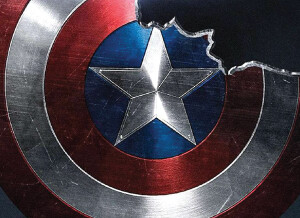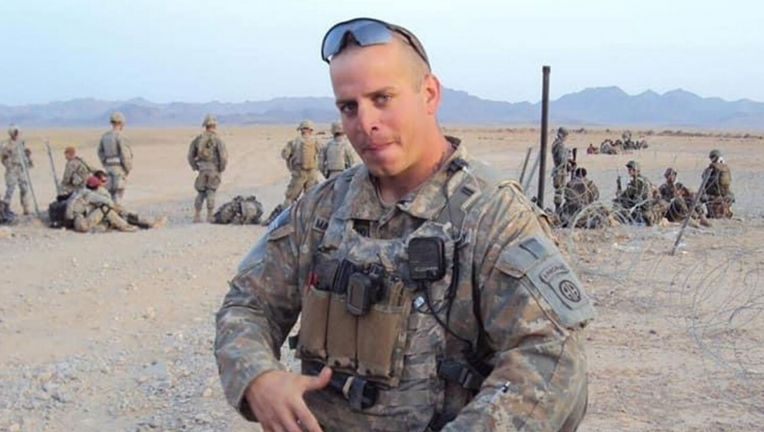
By MAJ Ben Richards, US ARMY Retired
 The iconic comic book hero Captain America commands a significant role in our national culture. His selfless commitment to service embodies the best of part of us. Having had the opportunity to observe a diverse cross-section of America’s people serve and sacrifice under conditions of great personal danger and privation, I assure you that the idea of Captain America is founded in fact, not in fiction.
The iconic comic book hero Captain America commands a significant role in our national culture. His selfless commitment to service embodies the best of part of us. Having had the opportunity to observe a diverse cross-section of America’s people serve and sacrifice under conditions of great personal danger and privation, I assure you that the idea of Captain America is founded in fact, not in fiction.
Andy Marckesano was one of those real-life Captain Americas. Just a few days ago, the 34-year-old Green Beret with a Silver Star and 12 combat deployments spent an evening reuniting with a friend and fellow Veteran of former battles. When he returned home, his three young children were already in their bedrooms asleep. He joined his wife, and then he took his own life.
The burden and pain of the invisible wounds of war had become too much.A decade earlier, as a young paratrooper in the 2-508 Infantry Battalion of the famed 82nd Airborne Division, Andy fought through a perilous combat tour in Afghanistan’s notorious Arghandab Valley. “We did things that people make movies about,” wrote one of Andy’s former leaders. The Valley extracted– and continues to extract– a high cost. The 800-man unit endured heavy combat casualties in Afghanistan, but even heavier casualties after returning home as the festering invisible wounds of war continued to extract their toll. Andy was the 30th member of that unit to take his own life.

When Captain America dies, our nation suffers.
Master Sergeant Marckesano’s death highlights the continuing failure of both the Departments of Defense and Veterans Affairs to combat the pernicious wounds of war effectively.
Why, after 19 years of war, have these agencies been unable to solve the problem of pandemic-level suicides among Combat Veterans?
The answer: they are trying to solve the wrong problem. They see the problem as being one of access to existing care. And the problem is mostly with the combat veterans themselves. By not seeking care for their invisible wounds at VA facilities, the combat veterans are the guilty ones. The VA leadership believes that if they can find ways to persuade these recalcitrant veterans to access care, then the problem will be solved.
But like the fabled emperor who confidently paraded before his people in his birthday suit, the problem with the emperor’s clothes is not his subjects’ lack of wisdom. The simple fact of the matter is that the methods the VA decided to use to treat the invisible wounds of war are not effective.
In a 2014 review of the state of medical care for combat veterans, the National Academy of Sciences found that veterans with PTSD who received treatment a the VA’s top-tier specialized PTSD treatment programs failed to achieve any clinically significant improvement after an average of 46 days of treatment. In 2015 a group of VA researchers reported in the journal of the American Medical Association (JAMA) that the VA’s own data showed their treatment methods rarely worked. “The outcomes from [Randomized Controlled Trials],” they reported, “suggest that only a minority of veterans can be expected to lose their PTSD diagnosis as a result of getting [therapy], arguable administered in ideal fashion….” In another publication, the same authors concluded, “There is an urgent need for innovative treatment strategies.” Furthermore, VA doctors persistently prescribe cocktails of off-label medications for invisibly-wounded veterans which, according to the VA’s own published treatment guidelines, not only have little or no evidence supporting their use, but are contra-indicated because of the strong evidence of harmful side effects.
The future of hundreds of thousands of invisibly-wounded combat veterans depends on the VA’s ability to solve three inter-related problems.
- First, the VA’s current approach to treating the invisible wounds of war is ineffective.
- Second, a substantial portion of veterans, perhaps even a majority, experience the VA as a hostile organization.
- Finally, the existing benefits system strongly disincentivizes, limits, and sometimes even prohibits veterans disabled by invisible wounds from healing or achieving the quality of life requisite for good health.
Over a decade ago, Stand For The Troops (SFTT) established a Medical Task Force of nationally- and internationally-prominent medical providers and researchers. These specialists have identified several therapies and treatment approaches that have demonstrated in both clinical trials and practice significant effectiveness in treating the invisible wounds war. These include modalities such as hyperbaric oxygen therapy, repetitive transcranial magnetic stimulation, direct current neurofeedback, and targeted hormone and vitamin supplementation. These therapies are safe, effective both in terms of their clinical outcomes and their cost, and available now.
Even a superficial survey of news stories, congressional reports, and conversations with your combat veteran neighbor next door, quickly reveals abundant evidence of systemic problems with the VA’s institutional culture. This culture has transformed it from the beneficent servant of the disabled warrior into a rogue bureaucracy bent on self-gratification and hostile to the veterans it was created to serve. Imperviousness to the revolving door of senior VA managers indicates the problem is much deeper than the top levels of management (I think it would be going too far to call them leaders).
The VA’s political masters could implement three policies that could rapidly disrupt and reform the extant institutional culture.
- First, the President and Congress could draft thousands of active-duty officers and senior noncommissioned officers to lead the VA’s middle and senior management echelons. These men and women are among our nation’s best. During their years have service these leaders have learned to solve complicated problems and overcome bureaucratic limitations while demonstrating integrity while understanding what it means to put others’ needs before one’s own– and all without civil service protections. By recruiting senior officers and noncommissioned officers nearing military retirement, charging the VA budget for their salary and pro-rated portion of their retirement benefits for their tour at the VA, the VA could gain the benefit of real leadership without impacting the military services’ personnel readiness.
- Second, the VA could provide TRICARE-equivalent health insurance as an alternative to requiring them to seek care at VA facilities. The VA is already short the capacity to serve the existing veteran population, especially veterans who live far from VA hospitals. Routine VA care is certainly no better than civilian care in most areas, and as outcome studies have demonstrated, the VA is not effective in treating combat-related injuries anyway. Veterans could be given a choice between using TRICARE insurance (TRICARE is the government-provided health insurance program for active and retired military members and their families) or seeking care at VA hospitals just like TRICARE recipients can choose between receiving care from civilian providers or a local Military Treatment Facility. The way the VA has implemented the congressionally-directed CHOICE and MISSION ACTS is not equivalent to TRICARE like insurance. Third, the DOD could assign large numbers of active duty medical providers to serve tours in VA facilities. The VA would pay the salaries and pro-rated benefits for these medical professionals. This policy would enable the DOD to substantially expand the number of medical professionals on active duty.
- Finally, the VA must reinvent its benefits system to help, not hinder, disabled veterans from achieving a good quality of life. The current benefits system already leaves disabled veterans at the edge of poverty. These veterans face drastic financial consequences if they make even minimal improvements in their health that do not substantively improve their ability to work or function. Furthermore, these veterans are effectively prohibited from engaging in even minimal, part-time work without losing many multiples of their potential income in benefits. For example a veteran who makes only $800 could easily lose over $1,400 a month from their disability pension for the rest of their life. Furthermore, vocation, whether compensated or uncompensated, is a crucial component of quality of life. Opportunities to engage in even limited vocational experiences promote well-being. For these veterans, vocation is part of rehabilitation, not the purpose of rehabilitation.
I have a young son who loves to read about and play superheroes. Like so many other children of active duty and veteran warriors, he sees me as his own real-life Captain America.
We have failed too many Captains America, but if perhaps it is not too late to save my son’s.
ShareAUG
2020

About the Author: